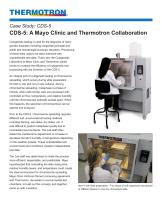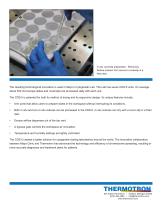
Catalog excerpts

CDS-5: A Mayo Clinic and Thermotron Collaboration Cytogenetic testing is used for the diagnosis of many genetic disorders including congenital (prenatal and adult) and hematologic/oncologic disorders. Processing of these tests used to be labor-intensive with unpredictable test data. That’s why the Cytogenetic Laboratory at Mayo Clinic and Thermotron joined forces to increase the efficiency of cytogenetic test processing with the invention of the CDS-5. An integral part of cytogenetic testing is chromosome spreading, which occurs during slide preparation for both in situ and non-in situ cultures. During chromosome spreading, metaphase (a phase of mitosis, when cells divide) cells are processed with controlled air flow, temperature, and relative humidity until the chromosomes optimally spread apart. When this happens, the specimen (chromosomes) can be stained and analyzed. Prior to the CDS-5, chromosome spreading required different and unconventional testing methods including flaming, wet slides, dry slides, etc. It was difficult to predict metaphase quality due to inconsistent environments. The Lab staff often asked the maintenance department to increase or decrease the lab’s humidity or temperature depending on the weather outside. These unpredictable test environments and conditions created undependable test data. The Lab staff was determined to make the process more efficient, dependable, and predictable. Mayo hypothesized that controlling the slide drying time, relative humidity levels, and temperature could create the ideal environment for chromosome spreading. Mayo Clinic Ventures formed a licensing agreement with Thermotron, the leader in environmental test chambers, to build out this concept, and together, came up with a solution. Non-in situ slide preparation: Two drops of cell suspension are placed at different places on one dry microscope slide
Open the catalog to page 1
In situ coverslip preparation: Removing fixative solution from around a coverslip in a Petri dish. The resulting technological innovation is used in Mayo’s Cytogenetic Lab. The Lab has seven CDS-5 units. On average, about 300 microscope slides and coverslips are processed daily with each unit. The CDS-5 is patented for both its method of drying and its ergonomic design. Its unique features include: • Arm ports that allow users to prepare slides in the workspace without interrupting its conditions. Both in situ and non-in situ cultures can be processed in the CDS-5. In situ cultures can dry...
Open the catalog to page 2All Thermotron catalogs and technical brochures
-
Product Dewpoint Control
1 Pages
-
Battery Test Chamber
1 Pages
-
Access Ports
1 Pages
-
Universal Port - SE-Series
1 Pages
-
Thermotron Company Profile
4 Pages
-
VNC Viewer
1 Pages
-
Solid Walk-in Chamber
2 Pages















